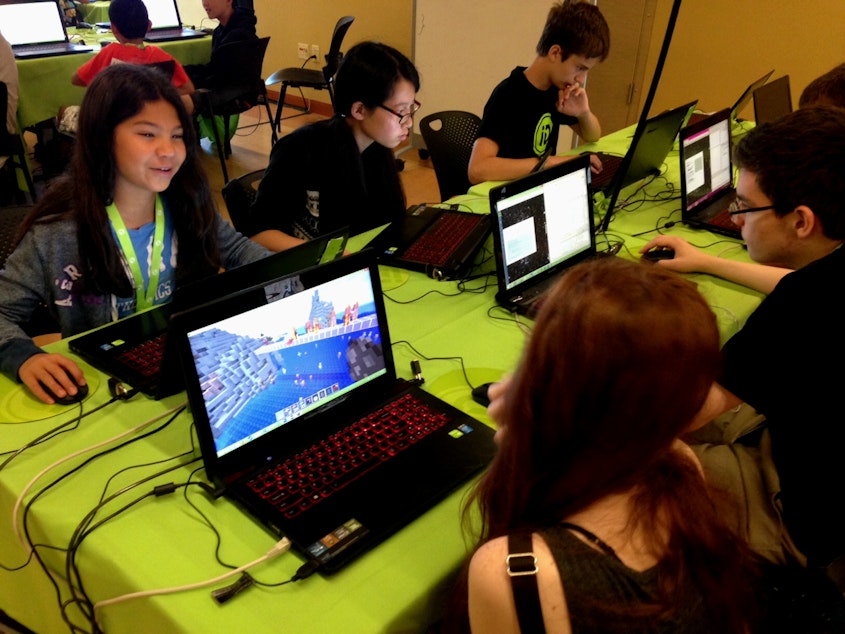Using Minecraft (And Zombies) To Teach Coding And Math Skills

Teenager Alea Frydnlund is creating zombies.
“It will attack you if you’re on survival,” she says. “But right now, I’m just on creative.”
Alea hunches over a screen in a classroom at the University of Washington. Her bright red hair falls in her face as she rattles off terms – survival, creative – for Minecraft, the wildly popular videogame that is dipping its toe in education.
Kids love playing the game so much that teachers and summer camps around the world use it as a way to teach computer programming, history and even physics in their classrooms.
Microsoft bought the game last year, and the company recently launched a website, education.minecraft.net. The site allows teachers to read up on how to make the game educational. They also want to collect data on how teachers are using it.
Sponsored
In the large classroom in the UW's Ethnic Cultural Center, teenagers are immersed in the visuals on their laptop screens.
They're in a week-long Minecraft Modding and Java coding camp called ID Tech. They've been creating and testing Minecraft Mods, making tools for this virtual world.
During the day, the kids are like surgeons operating on a digital patient, opening up the game to reveal the code beneath.
They then tweak or create new tools within the game such as super fantastic pickaxes, or glowing magical swords by manipulating the base code for Minecraft.
But is this educational?
Sponsored
That question inspired Katie Davis, a University of Washington Information technology researcher to look into it.
"I started to hear from parents that their kids are playing so much Minecraft," Davis says. "On the one hand, it seems like they're spending so much time on it and tune everything else out. On the other hand, they seem to be learning things.”
Davis wants to know if the game really does have the education value that some claim.
She says there's a lot of talk about how Minecraft can help kids learn specific skills, like coding, physics, math, creativity and collaboration.
And Davis, a former elementary school teacher, notes that while there's a lot of excitement surrounding that claim, there's very little data to back it up.
Sponsored
“If it’s going to succeed, we need to find some happy balance between identifying specific skills that kids are learning, so that we can justify its inclusion into the curriculum, but also carve out space so that kids can play it as unconstrained as possible,” she said.
She began to research how kids collaborate when they play Minecraft in a group. So far, Davis says that collaboration in Minecraft looks very different depending on the variables: the groups of kids you have, the tasks that you give them, their expertise level and so on.
Another thing Davis learned involves the freedom kids feel they have while playing the game.
"The kids really like the fact that in Minecraft they're free," she says. 'Especially when they're playing in creative mode. They're free to create whatever they want, go wherever they want. And that is so different from how they experience school and the classroom."
For now, Minecraft education appears to be more common at camps than in the classroom, which leaves some kids out. High-end tech camps for kids, like ID Tech can get pricey. A week-long ID Tech camp costs between $900 and $1,100 a week.
Sponsored
Such a camp might be out of reach for the kids in Norman Alston's Math enrichment program, called E-mode.
E-mode delivers math programs mostly to kids of color who live in Southeast Seattle.
Alston has used the Minecraft videogame to teach some math and building projects in the past. He was introduced to it by a parent of one of his students, who happened to work for Microsoft in the Minecraft Education division.
He's found that video games and technology have inspired kids to learn math concepts.
"You don't teach kids Minecraft," Alston says. "If you give a kid an iPad or some technology, you don't teach them. There's intuition, there's understanding; it’s just what they're growing up with, right?"
Sponsored
Alston says he has found obvious mathematical applications with the video game.
But on a recent visit to his class at a Tukwila elementary school, there were no computers or iPads to be seen. Rather, there were a few glass POM bottles, boxes of abaci and an assortment of pictures on the wall.
Alston says getting the funding he needs to keep his program running is a constant challenge. And he doesn't always have access to classrooms with the computers and other technology that he'd like to have at his disposal.
"There isn't enough,” he said. “When computers are available, they’re sluggish or they don’t work well.”
Alston will use what he can to teach kids math concepts. One of his favorite teaching tools is the abacus.
"I'm also thinking about bikes as a technology, I'm thinking about toys as a technology. It’s not always high tech,” he says. “You give me a slate, give me some mud and a stick – we're going to get the job done for these kids!"
This week he's kicking off a Back to School Mathematics Mini Camp at the Boys and Girls Club in Southeast Seattle.
Alston's goal is to create what he calls a Rainier Valley Mathematics Renaissance – with or without Minecraft. But he hopes that it’s with.

